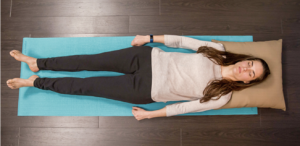Progressive Muscle Relaxation Steps
First off, find a quiet place free from distractions. Silence your cell phone, close any doors, and settle into a comfortable position where you won’t be disturbed or have to move around a lot, like a chair, recliner, or even the floor if it won’t make you fall asleep.
Loosen any tight clothing and remove glasses or contacts. Rest your hands in your lap or on the arms of the chair. Take a few slow even breaths. If you have not already, spend a few minutes practicing diaphragmatic breathing.
Now, focus on the following areas, careful to leave the rest of your body relaxed.
- Forehead: Squeeze the muscles in your forehead, holding for 15 seconds. Feel the muscles becoming tighter and tenser. Then, slowly release the tension in your forehead while counting for 30 seconds. Notice the difference in how your muscles feel as you relax. Continue to release the tension until your forehead feels completely relaxed. Breathe slowly and evenly.
- Jaw: Tense the muscles in your jaw, holding for 15 seconds. Then release the tension slowly while counting for 30 seconds. Notice the feeling of relaxation and continue to breathe slowly and evenly.
- Neck and shoulders: Increase tension in your neck and shoulders by raising your shoulders up toward your ears and hold for 15 seconds. Slowly release the tension as you count for 30 seconds. Notice the tension melting away.
- Arms and hands: Slowly draw both hands into fists. Pull your fists into your chest and hold for 15 seconds, squeezing as tight as you can. Then slowly release while you count for 30 seconds. Notice the feeling of relaxation.
- Buttocks: Slowly increase tension in your buttocks over 15 seconds. Then, slowly release the tension over 30 seconds. Notice the tension melting away. Continue to breathe slowly and evenly.
- Legs: Slowly increase the tension in your quadriceps and calves over 15 seconds. Squeeze the muscles as hard as you can. Then gently release the tension over 30 seconds. Notice the tension melting away and the feeling of relaxation that is left.
- Feet: Slowly increase the tension in your feet and toes. Tighten the muscles as much as you can. Then slowly release the tension while you count for 30 seconds. Notice all the tension melting away. Continue breathing slowly and evenly.
Enjoy the feeling of relaxation sweeping through your body.
Continue to breathe slowly and evenly.
 Voice Recording
Voice Recording
In addition to following these instructions, try using a voice recording like the free MP3 audio file offered by McMaster University with directions on practicing progressive muscle relaxation. Using an audio recording lets you fully relax and concentrate on the technique.
Efficacy of PMR for Anxiety
A systematic review conducted in 2008 and published in the journal BMC Psychiatry showed the efficacy of relaxation training, including PMR for treating anxiety. So, if you’re seeking evidence-based options to treat social anxiety, PMR is a wise choice.
Relaxation techniques such as progressive muscle relaxation can help treat mild to moderate social anxiety, or when practiced alongside traditional treatment such as cognitive-behavioral therapy or medication.
Yet, if you are from suffering from severe untreated social anxiety, consult with a doctor or other mental health professional to obtain suitable treatment.

